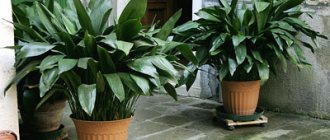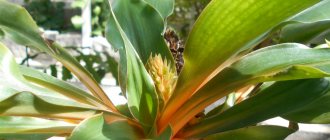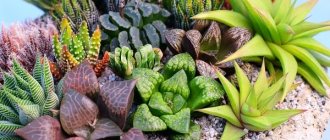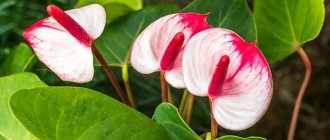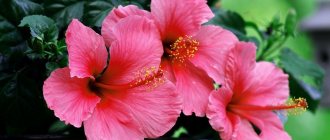The most famous, the most useful, the most unpretentious and, oddly enough, the most annoying - which green pet can you say that about? Of course, this is chlorophytum - a houseplant that can be found everywhere.
Even during the times of the Soviet Union, chlorophytum gained unprecedented popularity: it was grown in apartments, schools, clinics, and stores, that is, almost everywhere. Of course, at that time people were not spoiled by exotic home flowers, but still this is not the only reason for the widespread distribution of chlorophytum. The fact is that this plant combines both decorative properties and various useful qualities, which you will learn about by reading the article. Subsequently, the popularity of chlorophytum faded, and the minds of amateur plant growers were occupied by new fancy flowers.
[!] Recently, due to the popularity of a healthy lifestyle, interest in chlorophytum has begun to revive again.
Chlorophytum, whose Latin name is Chlorophytum, is a representative of the Liliaceae family (Latin Liliaceae), according to some scientists, or the Asparagus (Latin Asparagaceae) and Agave (Latin Agavoideae) families, according to others.
In the wild, chlorophytum can be found in the tropical rainforests of South America, Africa and Australia. The perennial has a particular preference for river banks with volcanic or sedimentary soils. The special structure of the roots with tuberous thickenings that accumulate moisture allows the plant to survive dry periods, which often occur in the tropics and subtropics.
In its homeland, Africa, chlorophytum is very popular, both wild and cultivated. Among the Nguni tribes, the plant is used both for medicinal purposes (especially for pregnant women) and as an amulet to protect mother and child. Chlorophytum is even used on a national scale: the perennial is planted on steep embankments and slopes to combat landslides and soil erosion.
The name comes from a combination of two Greek words - “chloros” (greenish-yellow, green) and “phyton” (plant), so in Greek, chlorophytum is simply “green plant”. Of course, this word form is not entirely correct, because many varieties of perennials are not only green, but also multi-colored: with cream, white and even orange shades. Chlorophytum was first widely studied, described and named in 1794 by the Swedish botanist Carl Peter Thunberg during an expedition to South Africa.
Chlorophytum is a representative of perennial evergreen herbs. In the natural environment, it reaches up to 1 m in height and in diameter; in home growing conditions, the maximum dimensions are about 40 cm. Long lanceolate leaves hang freely down, the stems are thin and curved, and a leaf rosette with aerial roots is formed at the ends of the stems. The flowers are small, white, collected in loose inflorescences of five to six pieces. The flowering of chlorophytum is not of decorative interest.
Botanical description
Chlorophytum is a herbaceous plant that forms a rosette of long, narrow and dense leaves. In indoor conditions, their maximum length reaches 80 cm ; in nature, the leaves can grow up to 120 cm in length. Their color depends on the variety and variety of the plant.
Chlorophytum flowers are small, paniculate, white or pinkish in color, located on long hanging stems (in some species they are placed on short peduncles). After flowering, new rosettes of leaves with aerial roots appear on the hanging shoots.
These new bushes can grow in the air for a long time, without soil, and produce new shoots. Because of this property, chlorophytum received the popular name “spider”, “air lily”. Period of abundant flowering: May-June. The root system is strong, with many shoots.
Benefits for people
Chlorophytum gives off most of its beneficial properties when watered. Taking in moisture, the flower releases air enriched with phytoncides into the room. And this is very useful for people who have pulmonary pathologies. The plant is also useful for planting for allergy sufferers and people who often suffer from colds.
Another useful property of the plant is to absorb ammonia, nitrogen, formaldehyde, acetone, and carbon monoxide. Therefore, it is very difficult to do without such a plant if a person lives near the roadway.
History, legends
Indoor chlorophytum (photos, benefits and harms of the plant are described later in the article) have long been classified as a member of the lily family. Recent research by botanists has made it possible to move the flower into the classification of asparagus. There is still no exact definition, since the plant has characteristics of both families.
In nature, this herbaceous plant is found in the subtropical regions of Africa, Asia and South America. At home, chlorophytum prefers moist soils in valleys and on river banks. Its branched root system allows the plant to be used to strengthen slopes.
As a houseplant, chlorophytum quickly spread throughout Europe from the end of the 19th century. The Latin name of the flower translates as “green plant.” The first botanical description of a subtropical grass dates back to 1794.
The unique ability of chlorophytum to survive in any conditions has created its reputation as a family flower for the comfort and well-being of the home.
Several folk signs are associated with this plant:
- Chlorophytum is considered a male flower; its presence in the home of unmarried women should bring good luck in their personal lives. The plant develops its strength especially well in the vicinity of such “female” flowers as violets, begonias, and cyclamens. Thus, its energetic influence is enhanced.
- Slow growth or wilting of chlorophytum signals the presence of negative energy in the house.
- It is believed that the plant is capable of taking on the diseases of its hosts. At the same time, the flower itself fades and gets sick.
- One of the popular names for the flower is “family happiness.” Legend says that in a house where chlorophytum is well cared for, there are no quarrels, peace and mutual understanding reign.
Experts in the ancient Chinese teaching of space arrangement, Feng Shui, endow chlorophytum with many positive qualities. They recommend that everyone who moves into a new home be required to have plants. It is believed that several flowers in different parts of the house can cleanse it of the heaviest energy. To do this you need the correct placement of the flowerpot.
- It is useful to place chlorophytum in the darkest and most remote parts of the room, since negativity accumulates there.
- It is useful to place strong, dense plants in the place where the deceased person was.
- Chlorophytums in a place of rest will help relieve stress after a hard day in 30-40 minutes.
- A flower in the northern part of the house will help you make decisions to change your life.
- “Green Lily” in the office is associated with satisfactory business management and increased income.
- A plant in a schoolchild or student’s room helps in mastering educational material.
What does it look like in the interior?
One of the well-known names of some varieties of Chlorophytum is “Splash of Champagne”. So it was deservedly nicknamed, because of the characteristic tails at the ends of the shoots, which resemble air bubbles flying in different directions. In any case, these types of flowers will greatly decorate the interior, because they look quite exotic.
But most of the remaining Chlorophytums are not the most eye-catching indoor flowers. They are characterized by an abundance of foliage and a large number of developing shoots, but the appearance is quite familiar and standard. For this reason, Chlorophytum is easy to combine with any indoor environment, from the most conservative classics in design to modern ones: high-tech, modern, neo-modern, underground.
Chlorophytum in the interior
Benefits and harms, can it be kept at home?
Indoor chlorophytum (photo), the benefits and harms of which are explained by the chemical composition of its leaves, has a number of advantages:
- The plant is valued, first of all, for its ability to purify the air from harmful impurities and gases, which is especially important for residents of large cities. Flower growers advise adding a little activated carbon to the soil for chlorophytum to enhance the cleansing effect. It takes 24 hours for a flower to remove harmful elements, which makes it a champion in terms of usefulness among houseplants.
- The phytoncides that the flower secretes kill most pathogenic bacteria within a radius of 2 m. The antimicrobial effect is enhanced by proximity to geranium.
- Chlorophytum humidifies the air around it, which is especially important for people with respiratory problems and allergies. Four mature plants in a room are enough to create a microclimate that is optimally favorable for health.
- Healthy chlorophytum is never affected by insect pests and protects nearby plants from them.
- In the rooms where the flower is located, dust deposition is significantly reduced.
Chlorophytum is a unique plant for any home. It will purify the air in the bedroom and living room no worse than an air conditioner, and helps remove unpleasant odors in the kitchen. All the harmful substances that chlorophytum absorbs from the air contribute to its lush growth. What is harmful to humans is very beneficial for this plant.
Its ability to develop in any conditions allows the plant to be grown in rooms with varying degrees of light.
Indoor chlorophytum will be of great benefit in creating a microclimate at home; in addition, an adult plant with many “spiders” fits perfectly into any design (photos confirm this).
The only caution is the advice to keep the flower out of the reach of small children. Harm can be caused by too sharp edges of the leaves, which can injure the delicate skin and mucous membranes of the child.
Growing conditions
Chlorophytums have always been highly valued for their high adaptability to indoor indoor conditions: dry air, relatively constant temperature throughout the year, limited nutrients in the soil, and ease of care.
On the contrary, it is more difficult for Chlorophytums to exist in the wild, because they tolerate high humidity less well, but geographically they grow precisely in tropical and subtropical regions where there is excess moisture for them.
BY THE WAY. Chlorophytum is famous for its ability to purify the air well. Therefore, it will not only decorate your home greenhouse, but will also be beneficial for the health of others. It is known that in the immediate vicinity of the Chlorophytum bush, up to 80% of pathogenic bacteria die. All this is thanks to the phytoncides that the flower releases into the environment. Three to four plants clean a room of up to 10 m2. They effectively absorb formaldehyde, carbon monoxide, and toxins that are dangerous to humans.
Therefore, for all varieties of Chlorophytum, there is practically no need to revise the care conditions established in the room where it will grow.
Chlorophytum in the wild
Temperature
In terms of room temperature, Chlorophytum is not very whimsical. He will be quite happy with the range of +15-25 Co. Do not need anymore.
In summer, the flower can and is even recommended to be moved to the balcony or open air (on an ongoing basis until late summer). However, it is only important to choose a place without strong drafts and not to allow large amounts of rainwater to fall on the foliage, otherwise the appearance of the bush will quickly deteriorate.
In the winter months, Chlorophytum will withstand even a strong drop in temperature in the room, but not for long. In general, this plant can be quickly destroyed only at a constant temperature below +10 C.
Air humidity
Chlorophytum has long been classified as a member of the Liliaceae family. But modern scientists classify this plant as Asparagus or Agave - opinions are still divided.
But all these families are characterized by growing in the wild in conditions of high humidity, although in fact, they require moisture within reasonable limits, no more. As for Chlorophytum, the frequency of watering is easy to work out. The soil in the pot should always be moist, but not too soggy, like in a swamp. On the hottest days, spraying will not hurt.
Dry air will certainly spoil the green cover: the leaves begin to dry first at the tips, and then all the way to the base. Therefore, sometimes you will need to humidify the air in the room. You can get by with a simple old-fashioned method - place a saucer of water nearby, which will gradually evaporate, naturally humidifying the air in the room.
It is especially important to pay attention to additional air humidification in winter, when the heating is on, drying out the room. It is for this reason, by the way, that Chlorophytum should be located at a distance from the batteries: at least 1.5-2 m.
Lighting
Remember that Chlorophytums, of all external care conditions, are the most picky about lighting. Their place should be illuminated with diffused light most of the day.
At the same time, the plant can withstand direct sunlight, but not more than a couple of hours a day, otherwise the delicate foliage will dry out quickly.
If you do not provide Chlorophytum with enough lighting, it will instantly wither and lose its healthy appearance. And if we talk about species that have variegated colors, then their leaves without proper lighting become standard, completely green without spots or patterns, that is, they lose their identity. On the other hand, when lighting is restored, the color quickly returns to normal.
Chlorophytum loves diffused light
Choosing a place to put a flower pot
It is believed that Chlorophytum feels almost ideal on the windowsill - where there is always enough light.
On the other hand, there may be little light on the north side, and too much direct sun on the south side. This gives rise to a logical conclusion: the best windows for placing Chlorophytum should face the western or eastern side. It will be light there most of the day, but the sun itself will not be too aggressive.
If I may say so, Chlorophytums are not averse to “taking a walk.” In the summer in the middle zone, they can be safely taken outside if conditions permit (for example, in a private house and your own yard). But you should choose the location more carefully: the flower will do well where there is no strong wind, and where rains cannot flood the root system, spoiling the appearance of the leaves.
Chlorophytum on the windowsill
Kinds
In the natural habitat, there are about 250 varieties of chlorophytum. Several species have been adapted for indoor keeping, some varieties of which have already been bred through selective breeding.
| View | Description | Peculiarities | Varieties |
| Crested | It grows in the form of a lush bush, long curved leaves are collected in small bunches. The color of the leaves depends on the variety. Flowers are white inflorescences on long shoots. | The most common indoor type. It can fire several arrows at the same time, which turn into new bushes. As a result, the flower becomes like a green fountain. Easy propagation by air layering. |
|
| Cape | The bush is a rosette with wide large leaves 60-80 cm in length. The leaves, pointed at the ends, have a groove in the central part. Leaf color is glossy green. The flowers are white paniculate, located on a short peduncle. | After flowering, it does not form air layering; it reproduces only by division. | |
| Winged (orchid star) | The leaves are large, oval, 30-40 cm in length. Appearance - a bush with long fleshy cuttings of bright shades from brown to bright red. Peduncles are short cobs. | Significantly different from all types. Can be propagated by division or seeds. Does not like direct sunlight. The combination of bright roots and green leaves creates an unusually attractive appearance. |
|
| Laxum | Narrow drooping leaves form a tall, dense rosette. The leaf color is green with a white stripe. Peduncles are low, spike-shaped shoots. | A very rare species. Does not produce air layering. Propagated by division or seeds. |
Varieties and varieties
Basically, in home floriculture, only 5 varieties of Chlorophytum are most widely used, although more than 200 varieties are known in the wild. Other species, besides the popular varieties, are very rare and are found in greenhouses only by the most experienced gardeners, as they are more demanding to care for.
Crested Chlorophytum
Almost completely standard Chlorophytum with long, oblong leaves growing almost from the very root. In an adult and healthy state, the rosette of a bush can reach up to half a meter in diameter (that is, very lush).
A distinctive feature is that crested Chlorophytum shoots bare long shoots, at the end of which lush shoots with leaves or flowers (rarely) are formed. Thanks to this feature, such a flower is often compared to a fountain or those very “champagne splashes”.
Curly Chlorophytum
It is very different from the crested one in that it is noticeably smaller in size, its leaf plates are folded into neat spirals.
The leaves in the central part have a thin light stripe, which appears only in good light.
Winged Chlorophytum
A variety characterized by the presence of wide leaves with an orange color at the base.
This variety is considered decorative, as it rarely grows more than 50 centimeters in height.
Cape Chlorophytum
A flower that looks great thanks to its special leaf shape and color. With proper care, it can produce leaves up to half a meter long, although it itself looks quite short and compact.
Cream shades of the foliage border are truly rare, which is why they will invariably decorate the interior and attract attention.
Chlorophytum Laxum
This is a very rare variety of domestic Chlorophytum, which grows to a small size, and the most remarkable part is the foliage. Laxum's leaves are thin, with white stripes on the sides.
Is it dangerous for cats?
Many cat owners are worried that some pets bite the leaves of chlorophytum. Indeed, many cats like the taste of this plant. There's no need to worry. The grass cannot cause any harm. Rather, on the contrary, the microelements that are present in the juice of the plant have a beneficial effect on the digestion of animals.
Cats often vomit after ingesting chlorophytum leaves. This fact gave rise to the myth that the flower is very harmful. In fact, this action cleanses the cat's stomach of the hair that has accumulated there. For thick-haired breeds, veterinarians even prescribe special products that cause a gag reflex.
Is chlorophytum harmful?
This plant is not considered poisonous and is therefore absolutely not dangerous. You can work with the flower without gloves, the skin of your hands will not be harmed. There were also no cases of an allergic reaction to chlorophytum.
Can chlorophytum cause harm to children and pets? Yes maybe.
Cats are often tempted by the tasty leaves of the flower; they look very much like “cat grass.” This herb helps them get rid of hairballs in their stomach. Having eaten to their fill, cats induce vomiting, and the cleansing of the body is completed.
But chlorophytum is not the best substitute for a miraculous cleanser, and the eaten flower looks unattractive. Therefore, in order to discourage your pet from this plant, it is advisable to plant this very special cat grass in a separate pot. Both will be satisfied: both the cat and the chlorophytum.
Children also often pull young flower shoots into their mouths, looking like small fluffy fountains.
IMPORTANT! Even young leaves of chlorophytum are very hard along the edges of the leaf blades and can damage the delicate mucous membrane of the mouth and stomach of a child.
Based on all of the above, we can safely say: the benefits of chlorophytum are enormous! This flower is rightfully considered a real fighter for clean air and a healthy atmosphere.
How to care for chlorophytum
Indoor chlorophytum (photos, benefits and harm confirm its popularity among gardeners), for all its unpretentiousness, reveals its beauty and usefulness to the fullest extent possible, subject to the most optimal conditions.
Temperature
Chlorophytum feels great at normal room temperature; it does not require special insulation in winter or cooling in summer.
Features of indoor Chlorophytum flower.
Optimal temperature conditions: 15-25o. Minimum temperature at which the plant maintains active life: 7o.
Lighting
Chlorophytum is one of the plants that can be used to decorate the darkest places in the house, corridors and bathrooms. However, it should be remembered that the color of the leaves in this case becomes less bright, and the multi-colored pattern may disappear. With sufficient lighting, the bush grows more luxuriantly, produces more flower stalks, and the color acquires all the shades familiar to the variety.
The ability to purify and humidify the air also manifests itself with a sufficient level of lighting. The best placement option is a place where the flower will receive direct sunlight until noon and receive shading in the afternoon. In summer, chlorophytum feels good in the fresh air, but does not like strong winds and drafts.
Watering the plant, humidity, spraying
If you leave chlorophytum without watering for a long time, it will be able to maintain vitality by receiving moisture from the air. But you shouldn’t constantly keep the flower under conditions of rare watering. Chlorophytums of all types love moderately moist soil and humid air.
In summer, watering is carried out 2 times a week, in extreme heat and dryness it can be done more often. In winter, the amount of water is reduced. The plant loves to be sprayed with water at room temperature. Water for irrigation should first be settled, since the salts in it increase the acidity of the soil over time.
Pot and soil
The best material for flower pots is clay or ceramics. When planting a new plant, you do not need to choose a container that is too large, since in such conditions the chlorophytum will grow slowly and not produce flower stalks. The root system of chlorophytum grows very quickly, and a pot that has become cramped may burst.
When replanting, you need to select dishes that will be approximately 10% larger than the previous one. The plant is replanted annually in spring or autumn.
Chlorophytum prefers neutral soil with an average pH index. A store-bought universal mixture is suitable. You can prepare the soil yourself by mixing humus, sand, turf and leaf soil in the proportion: 1:1:2:2. A drainage of pebbles, screenings, and small pebbles must be placed at the bottom.
Top dressing
Chlorophytum responds well to fertilizing with vigorous growth and abundant flowering. You can use any fertilizers with a complex composition. The frequency of fertilizing is once a week during the active growing season, from March to August.
Bloom
The flowering period of chlorophytum usually begins with the onset of spring, in March, and continues throughout the growing season. To stimulate greater splendor of the bush, flower stalks can be cut off.
Houseplant Chlorophytum - description
In general, chlorophytum is the name of more than one plant. This is the name of a whole genus of herbaceous perennials. And the genus is part of the family... This is where scientists begin to disagree: previously, for example, chlorophytum was classified as, surprisingly, the lily family. However, now they have reached a consensus and decided that this is still the asparagus family.
Chlorophytum is loved for its appearance, although not as bright and exotic as that of an orchid or rose, but pleasant and uplifting. They also love it for its beneficial properties: it is believed that chlorophytum absorbs harmful compounds that contain oxygen around it - this helps it nourish the microorganisms that live inside it and keep it healthy.
And with abundant watering, chlorophytum can even humidify the air. Therefore, it is often started by people with problems with the respiratory system or who want to freshen the air a little at home.
What does chlorophytum look like?
Like a low (up to half a meter in height) bush, practically devoid of a stem - long leaves come straight from the root. They are elongated, pointed in shape, do not stick out upward, on the contrary, they hang down, resembling either disheveled hair or a small green fountain. The root, on the other hand, is thick and hard, white in color, prone to moisture gain, since the plant comes from arid regions and must somehow survive during periods of drought.
The basis for the decorativeness of chlorophytum is, of course, its long (15-60 centimeters), narrow (three centimeters) leaves, so breeders have already developed many different species: without white stripes, with them, with yellow stripes, with different “styles” of green hair. Sometimes chlorophytum is even grown in an aquarium to decorate a room: behind glass, surrounded by a miniature landscape, it looks not just like a flower, but like a miniature jungle.
Blooms or not
With good care - yes, of course, it blooms, starting from the second year of life, just not very noticeably, not decoratively. It blooms from March to September, with small buds with thin white petals on long stems. The main reason for the lack of flowering is a pot that is too large, due to which the plant actively develops roots, but does not develop the above-ground part.
How fast it grows
Fast enough. In the first two to three years of its life, it requires an annual repotting because it grows out of an old pot. Then transplants are done less frequently.
Are Chlorophytum Poisonous or Not?
Absolutely non-toxic: no juice, no leaves, no fumes from chlorophytum, no flowers. It’s not even dangerous for pets if they suddenly decide to eat it. However, you still shouldn’t let them gnaw the plant - then it won’t be beautiful, and the gnawed leaves will turn yellow.
Homeland of the plant
South Africa.
Reproduction
Indoor chlorophytum (photos, benefits and harms of the plant are given in the article) reproduces very easily, like many herbaceous plants.
Air layering
The most common type is Chlorophytum Bushy or the usual “spider”, easy to propagate by air layering.
To do this, they are simply cut off from the shoot and immediately planted in the ground, in a separate container. To guarantee, the cut bush can be kept in a bowl of water so that the roots grow more. Such natural layerings take root well.
Seeds
The easiest way to propagate Chlorophytum Winged is by seeds. For other species, this method is also suitable, but the percentage of seed germination is much lower. Seed material can be bought at flower shops or collected yourself at the end of flowering. The method of propagation by seeds requires more time and care, but it is possible to obtain a large number of seedlings at once.
The process looks like this:
- Before planting, the seeds should be soaked and wrapped in a wet napkin for a day.
- Scatter the seeds over the surface of the soil, without falling asleep on top.
- Cover the container with the seeds with film or glass to create a greenhouse effect and leave in a warm, sunny place.
- As the soil dries, it should be moistened with a spray bottle.
- Shoots appear in 4-6 weeks. After this, the seedlings should be accustomed to the environment by opening the greenhouse for several hours.
- After 2 leaves appear, the seedlings can be transplanted into separate containers for further growth.
Dividing the bush
This method is suitable for all varieties of chlorophytum, especially those that do not produce air shoots. A bush older than 3 years must be divided. When transplanting, it is divided into several parts and planted in separate containers.
Roots removed from the soil must be carefully inspected and any rotten ones must be removed. The soil with the transplanted parts of the plant is watered abundantly and left alone for several days for engraftment.
Bloom
Usually, chlorophytum holders do not ask the question “what to do to make it bloom,” because chlorophytum blooms rather inconspicuously, its flowers do not bring aesthetic joy, and seeds are usually not used for propagation. However, of course, chlorophytum blooms in small, white inflorescences with thin petals on a long thin stem.
How chlorophytum blooms: photo
When does it bloom at home?
From March to September.
How often
Once a year, with good care, if it is not taken care of, it may not bloom. The most common reason for lack of flowering is a pot that is too large, leading to fattening (excessive development of the root system to the detriment of flowering). The solution is to transplant it into a smaller pot.
Diseases and treatment
Chlorophytum is one of the most disease-resistant plants. Insect pests settle on it very rarely, if the flower is very weakened. The wilting and unhealthy appearance of the plant can only be associated with unfavorable living conditions.
- Often the appearance of chlorophytum is spoiled by the dried tips of the leaves. The reason for this phenomenon is very dry indoor air or insufficient watering. Dry parts should be cut off, if necessary, increase the amount of watering, and regularly spray the plants. If there are a large number of dried leaves, you can cut everything off at the root, improve the conditions for the flower and wait for the regrowth of the renewed bush.
- Sluggish and yellowed leaves of chlorophytum signal rotting of the roots due to excessive soil moisture. Replanting it in fresh soil will help save the plant. In this case, all rotten parts of the roots and limp leaves should be removed.
- Yellowing of leaves may also be due to insufficient lighting. Although chlorophytum is a very shade-tolerant plant, some varieties require more light. It is enough to move the pot to a more illuminated place for a while. Lack of lighting also affects the color pattern of varieties whose color consists of stripes.
- The green color sometimes changes to yellow when there is a lack of nutrients in the soil. This phenomenon can also be observed when the roots have occupied the entire area of the pot. The trouble of transplanting into a new container and new soil is eliminated.
- Brown spots on the leaves of chlorophytum appear in a damp and cold room, with excessive soil moisture.
- Paleness and falling of leaves in winter occurs with a lack of light and excessive dry air.
- If the topsoil is consistently dry, the tips of the leaves may become brown and wrinkled.
- Chlorophytum does not produce flower stalks for a long time, growth has slowed down - the time has come for replanting, the bush has become cramped in its previous container. Interestingly, a container that is too large for a small bush causes exactly the same problems as one that is too small.
The houseplant Chlorophytum is very beautiful (this can be seen in various photos). With its help, you can decorate premises of any purpose, size and location. The undoubted benefits of the flower with a minimum of harmful qualities allow us to recommend chlorophytum for both residential premises and offices.
Author: Nadya Boyko
Transfer
There is nothing difficult with transplanting Chlorophytums. Firstly, this plant does not need it very often, but only as the container is filled with roots (this can be seen by the clearly stopped growth). Secondly, the process occurs through the usual transfer, that is, with the preservation of a clod of earth from the old pot and the addition of new fertile soil.
It is best to wait until early spring to transplant. Then you can sufficiently feed the plant and reduce stress for it, since a time of growth and enhanced root formation is expected ahead.
Chlorophytum transplant
Signs and superstitions
Signs and superstitions associated with indoor flowers are varied, but all of them in one way or another relate to family happiness, health and well-being.
It is believed, for example, that houses in which indoor plants die or wither are filled with negative energy. However, there is a completely logical explanation for this: insufficiently competent care of indoor crops.
Unpretentious chlorophytum grows well in any room and, according to popular belief, brings happiness and tranquility to its owners.
Common mistakes
Chlorophytum foliage darkens - most likely this is a sign of some kind of physical damage. In rare cases, the problem may be too high a temperature or too much humidity.
Monochromatic leaves grow on variegated chlorophytum - in most cases, a sign of a serious lack of light. The problem goes away very quickly after changing the location of the pot.
The formation of rot is almost always associated with stagnation of liquid in the pot. They get rid of rot by significantly reducing the intensity of liquid application. By the way, sometimes rotting in Chlorophytums begins due to an incorrectly selected soil mixture - too dense a structure leads to flower diseases.
The tips of the leaves are fading - this means that the plant clearly does not have enough moisture. But this does not necessarily apply to watering. Sometimes this painful appearance is caused by too dry air in the room.




